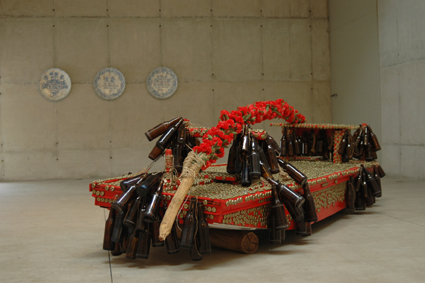Galeria Leme is pleased to present the collective exhibition Neobaroque, featuring works by João Pedro Vale, Camila Sposati, and Friederike Feldmann.
Under distinct techniques and optics, three artists of different nationalities present works that flirt with the Baroque, an artistic movement that emerged in Rome in the 17th century.
Camila Sposati, Brazilian – presents two different works originating from dolls and characters created by the artist – ‘Firearms,’ a sequence of nine photos where plasticine dolls (white tack) simulate a dispute, and two sculptures made from marble powder.
Regarding the work ‘Firearms,’ Sposati says: ‘I like to deal with boundary issues. In this work, I question who is the aggressor and who is the victim, who is passive and who is active.’ Camila, 34, develops a significant contrast between fragile and temporary materials. At the end of this almost documentary sequence, the artist doesn’t provide a solution to her question but abstracts it poetically for the viewer’s deeper reflection. In her sculptures, the marble powder resembles a decorative frosting on a party cake – the character, somewhat monstrous and somewhat deformed, doesn’t frighten but surprises, much like its wooden base, which portrays a non-existent instability.
João Pedro Vale, Portuguese – Galeria Leme welcomes the 30-year-old artist in April as part of its residency program. João exhibits the installation ‘It was a beautiful party, man,’ a title taken from the first verse of the political composition ‘Tanto Mar’ (1975/1978) by Chico Buarque. At the time, the music served to encapsulate the sentiment generated by the Carnation Revolution (April 25, 1974), a date that marked the peaceful transition from Portugal’s dictatorial regime to democracy. The work comprises a raft specially produced for the exhibition in the Northeast of the country, covered with beer bottle caps, including those from the Portuguese brand Sagres, homonymous with the Portuguese training ship and part of the southern region of the country, more associated with discoveries. ‘It’s as if the boat and its memories were forgotten at the bottom of the sea, covered by bottle caps,’ explains João.
João Pedro Vale is one of the main exponents of the contemporary Portuguese art scene and uses memory as one of his primary allies in the creative process. Throughout his trajectory, he has produced other works using boats, one of which was recently exhibited in the ‘Portugal Novo’ show at the Pinacoteca do Estado de São Paulo. João also evokes his native memory in the dishes he presents, made from packs of Portuguese Suave cigarettes, a name given to ornamental Portuguese architecture built during the military dictatorship era. The dishes’ patterns reference iconic 18th-century tiles, carrying words from popular poems in Portuguese and Brazilian literature, respectively by Augusto Boal and Fernando Pessoa. Similar to the Baroque, the works presented by João Pedro Vale expose social contrasts through the unification of body and soul, merging the erudite and the popular.
Friederike Feldmann, German – the artist exhibits four works from the poetic and intimate series ‘Zimmer’ (‘Rooms’). The images are reproductions of the most luxurious palace rooms, spaces that, according to the artist, contain auras and statuses suitable for reproduction through painting. These are respectively the King’s, the Queen’s, and the ‘Millionaire’s Room.’ One of the works also shows a reproduction of Marie Antoinette’s (1756-1798) room, the last queen of the old French regime. Friederike mixes silicone and acrylic paint as pigment, working with a bag similar to those used for decorating cakes, resulting in an ornate image filled with light contrasts. The sumptuousness and excesses of the Baroque movement, characteristics still echoed in artistic production today, appear more clearly in Friederike’s work, aged 44. Her paintings don’t merely surrender to expressiveness; their grandeur lies in the slow and patient transformation of her reproductions.
